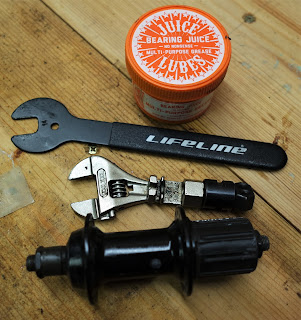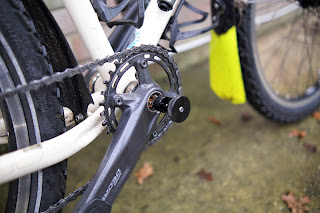Not had the cool, bright ambience
I’m particularly fond of, rather the rush and rumble of sugar beet being
funnelled into trucks and lanes carpeted in a mixture of leaves and acorns,
bringing a new dimension to riding. Acorns can prove surprisingly good at
testing a tyres traction, especially when the rains strike. No issues with the Maxxis
Ravager Maxxis
Ravager TR Tyres | cycling-not-racing, Rambler Maxxis
Rambler Tubeless Ready Tyres | cycling-not-racing, Vittoria and Continental
Pure Contact-plenty of feedback and compliant casings certainly help. The
Weldtite All Weather is doing its thing impeccably too. It’s a lower viscosity formula,
so a little trickier than some to get a really controlled, sparing coating on
the chain. Doing so rewards with much less grit, grot and ultimately need for weekly
wipes of the side plates. Fitting the Zefal
Crank Armor presented an ideal opportunity to check chain health-just shy of
.5, so a reasonable amount of life remaining. .7 is pension point for 10speed
chains, although sometimes, say following a more involved strip, or deep clean
and there’s a replacement to hand, I may switch at .6.
There’s no such thing as the
wrong weather, rather the wrong clothing- a phrase credited to Alfred Wainright,
back in 1973 but it certainly resonates with me, both throughout my riding
“career”. Basically, the notion we can enjoy any kind of weather, with the
right kit. Admittedly, while I accept punctures and other mid ride mechanicals are
“part of the ride”, not to mention product testing but they’re not my favourite
experience when it’s raining dogs in the wee small hours. While DWR coatings
found on jerseys are great for an unexpected showers and will typically buys 30
minutes to either reach home or don a technical jacket.
The Castelli Do Di Ci to my
surprise, forgoes the DWR component in favour of rapid wicking (which it seems
to do very effectively) although surprisingly enough, I’ve remained dry in the
showery contexts described above. On longer, or potentially changeable outings,
I default to Madison Road Race Super Light Men’s Waterproof Softshell Jacket Madison Road
Race Jacket | cycling-not-racing since its packable and offers a decent
level of protection. Unlike, the classic “condom” jacket, which are great if
you want to sweat some weight off, the Madison breathes very effectively and
packs nicely into a bigger wedge pack, assuming if like me, you prefer it
didn’t consume a jersey pocket.
Continuing the right kit
narrative, packable garments have their place and can be a serious godsend.
However, more persistently wet, wintry weather calls for a more traditional
technical jacket. A sudden onset of “stormy” weather saw me reaching for this
Showers Pass Elements Jacket SHOWERS
PASS MEN'S ELEMENTS JACKET | cycling-not-racing which boasts excellent 15000mm
waterproofing and breathability, not to mention some very clever
retro-reflective technology. The only thing I’ve really missed is a breast
pocket for easy access to my compact camera. It also proved an ideal
opportunity to don the Sidi Algor, which have held up very well against deep
standing water and similarly wet and occasionally gritty stuff. I’ve gone for
waterproof socks in the first instance but will also get soe miles in wearing
traditional merino blend socks to see how the boot’s water repelling properties
hold off the elements.
I was delighted to receive this
Altura Night Vision Storm Jacket. The Night vision could arguably be described
as something of an iconic model for commuting and general riding. I’ve used
previous versions long term and found them very practical and surprisingly
durable. Waterproofing and Breathability are 10,000mm apiece, which is my
yardstick, for this kind of garment-one that will wick fairly effectively when
turning a decent tempo.
That said, I prefer those with a
breathability rating closer to 15,000mm for longer, more intensive riding. Weight
is another consideration, this Altura tips the scales at just under 500g, which
again is typical of this genre of garment but a higher end model, such as this
Gore are around the 300g mark, which is quite considerable. Similarly, while
models such as the Altura are packable, we’re talking 126-20 litre pannier, or Bike
Packing Seat pack such as this PASSPORT
CYCLES BIKEPACKING SEAT PACK | cycling-not-racing or the Lomo 13 Litre Bikepacking Seat Pack Lomo
13 Litre Bikepacking Seat Pack | cycling-not-racing not rack bag, let alone
jersey pocket.
Fine on a tour, but not
necessarily ideal on a training run, or day ride. Oh, and if you’ve gone this
route (or at the other extreme, returned from a hell and high-water mission)
hang the jacket out to dry properly. Polyester blends are pretty easy to wash
too-pop in the machine at 30 degrees, minimal detergent, line dry (or indoors)
naturally away from sources of heat.
























